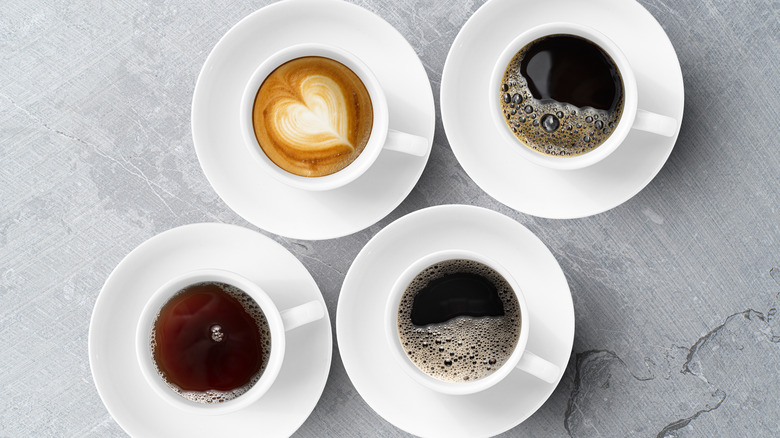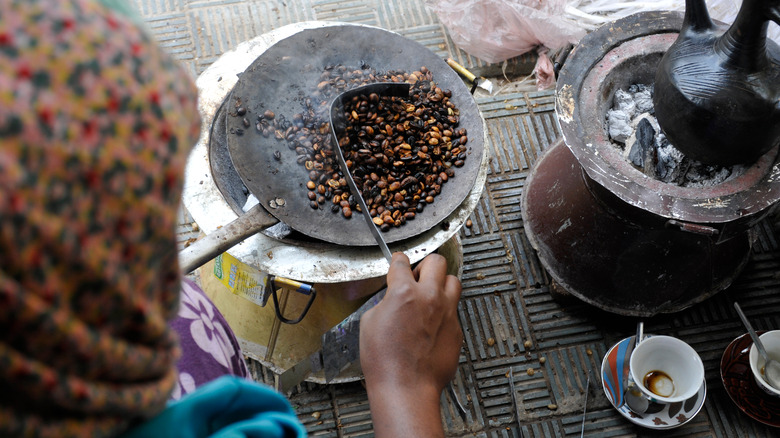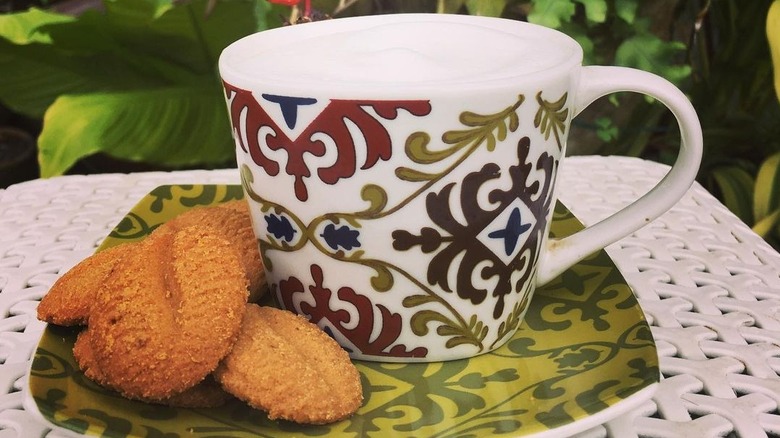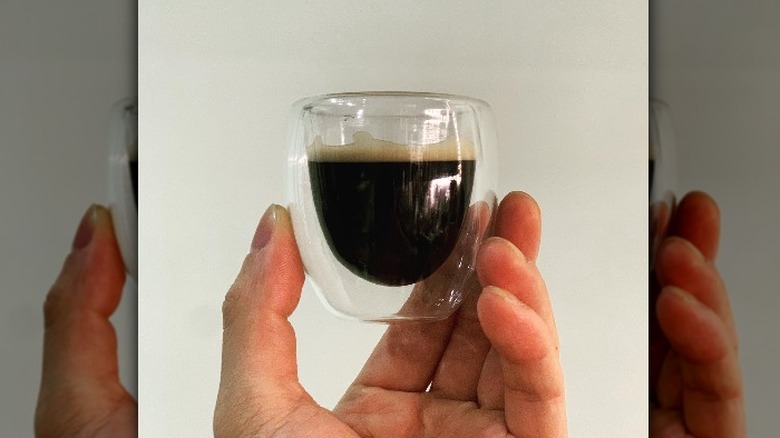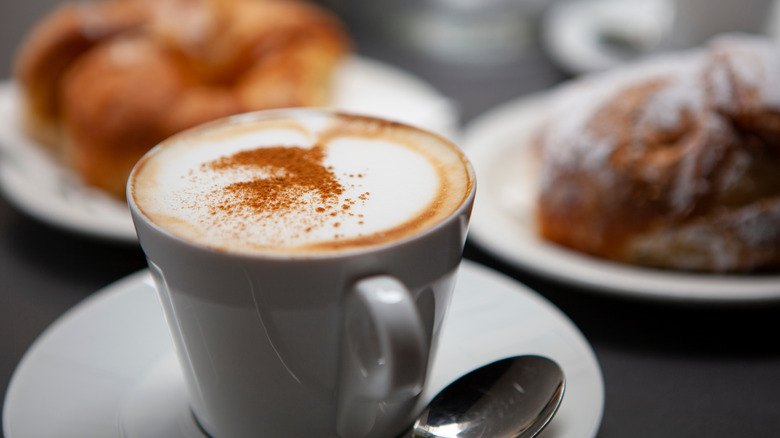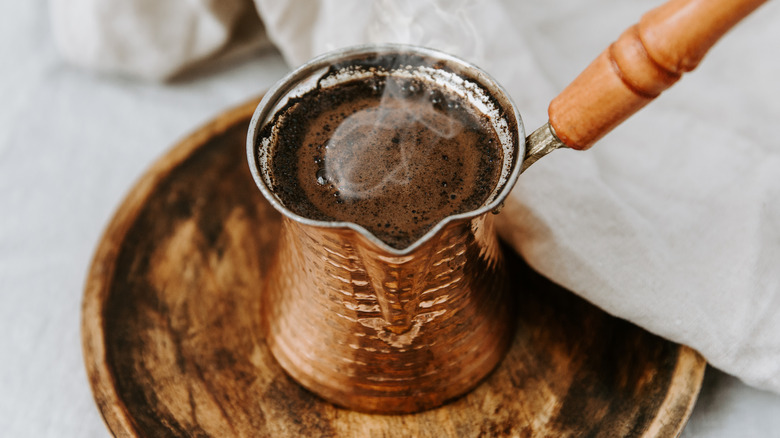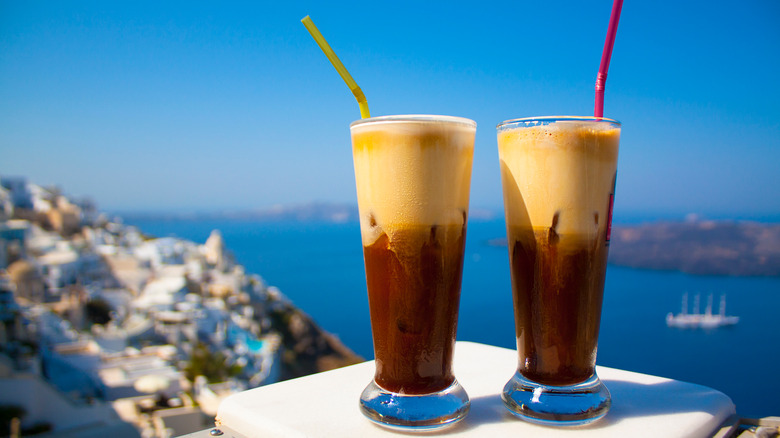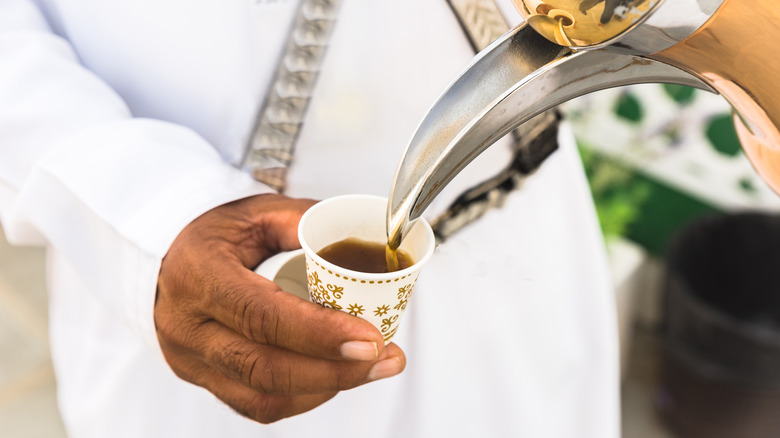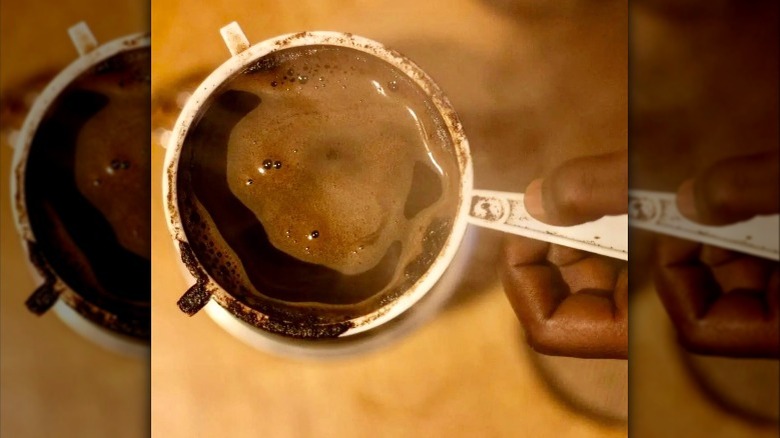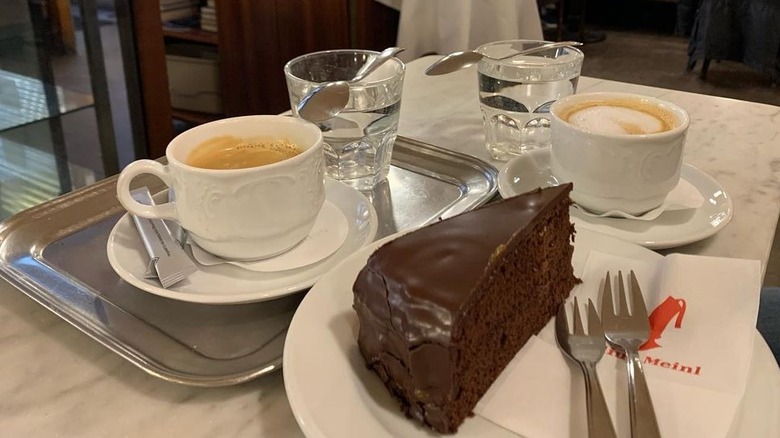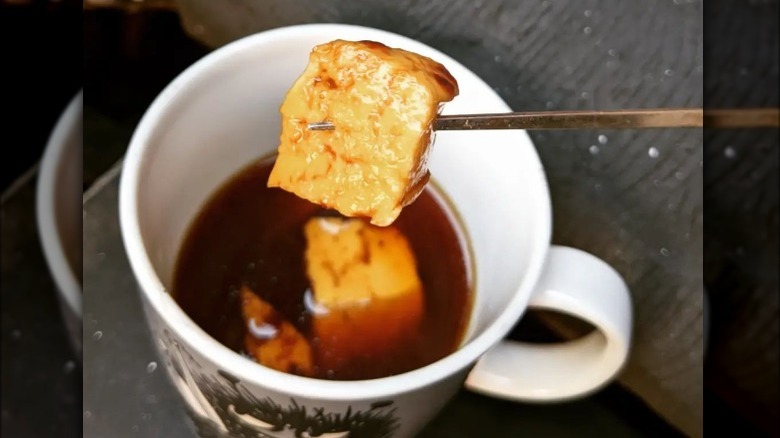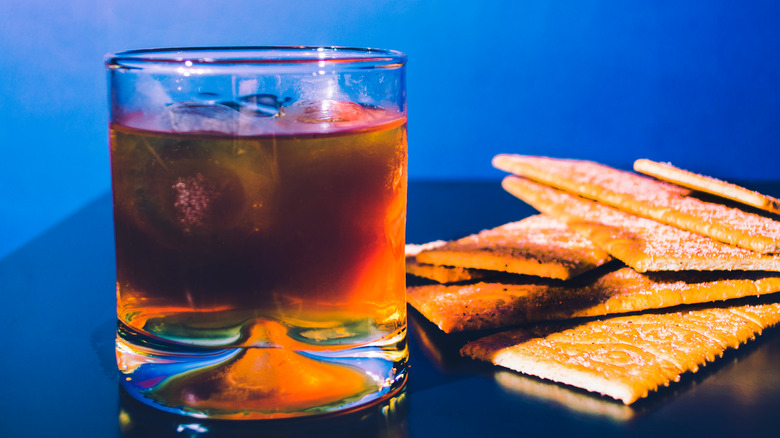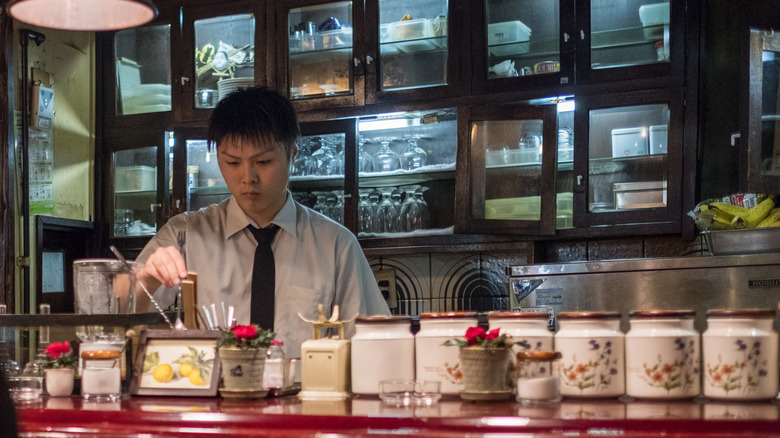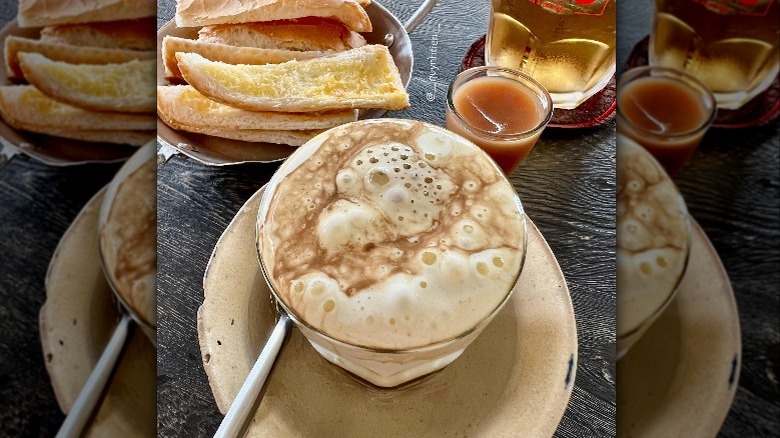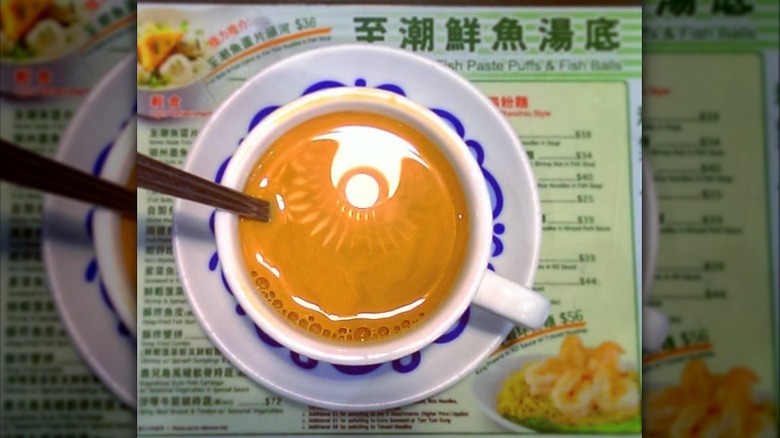How People Around The World Drink Coffee
It's safe to say that Americans love a good cup of joe, and according to some franchises, we even run on it. It's hard to dispute the wide choice of well-rooted coffee establishments and the fact that 40% of American kitchens include some form of a coffee-making device (via Statista). Movies showcase hurried assistants running with a venti Starbucks in hand or suave businessmen sipping espresso. Meanwhile, Tiktokers regularly include coffee content, such as whipped coffees which were all the rage in the spring of 2020.
As the sun greets the day, many Americans salute it with a warm cup of coffee. However, beyond the U.S., coffee defies borders and has consistently fueled trade, sales, economy, and culture. The influence expands further and as BBC describes, coffee is an unstoppable force. While this might sound a bit pragmatic and factual, on the other side of coffee's driving force is its enjoyment. In fact, the world is brimming with coffee lovers all over, each delivering a unique take.
Ethiopia
Ethiopia is regarded by many as the origin of arabica coffee (via The World Bank). Legend has it that long ago, a goat herder noticed his animals became energetic upon consuming red berries. After trying them himself and noticing a similar effect, he immediately brought his findings to a local monastery. In fear of evil, the monks threw the berries into a fire, where they roasted and were consequently brewed into the drink we know today.
The coffee bean has persisted and thrived as a cash crop and cornerstone of global cuisine. Ethiopia remains, as per The World Bank, one of the largest producers of coffee, and berries can be found growing in rainforests, plantations, and personal gardens. However, coffee production is only half of Ethiopia's story.
As profiled by the African Coffee Club, coffee drinking is a largely social undertaking in Ethiopia. Unlike other countries where one might settle down with a caffeinated concoction and some isolated scrolling, here it offers an opportunity to get together. In fact, the Ethiopian verb for getting together, buna tetu, literally translates to getting coffee. In Ethiopia, coffee is brewed over charcoal in a terracotta coffee pot (jebena). Once brewed, the coffee is served in uniform cups without milk save for at the occasional specialty shop. Sugar, a little bit of salt, or even some butter are welcome additions.
Colombia
As another major coffee grower, Colombia is chock-full of coffee lovers. The versatile plant has long been grown and enjoyed in the South American country, particularly among the indigenous population (via Perfect Daily Grind). Colombian production is often synonymous with coffee export, and unfortunately, what remains locally are the more lackluster beans called pasilla, Flavors of Bogota explains. Worse, the outlet notes that cheap coffee from other countries is sometimes imported.
Colombian coffee is usually brewed via a drip system, where grounds are placed in a coffee sock and hot water is poured over the top. Colombians typically start their day off with tinto, a small cup of coffee that is sweetened with sugar (via Flavors of Bogota). In fact, Colombian coffee is so sweet, that it is sometimes even made with simple syrup (via Oh My Veggies). Tintos aren't limited to breakfast though, and Colombians can be found sipping them from early in the day to late at night. Coffee is also served as a café; this is a frothy milk drink with minimal coffee, fitting somewhere between a cappuccino and a latte macchiato.
Cuba
This island country is known for its many features including a booming coffee culture. Cuba has a long entanglement with coffee, and Havana Times theorizes that it was formally introduced to the island by the Spanish conquistadors. The coffee plant took well to the mountainous soils of the island, which are still predominantly reserved for organic coffee cultivation (via Insight Cuba).
Cuban coffee is markedly darker than other varieties, and as described by Insight Cuba, raw sugar is mixed into the espresso as its being made, thickening it and producing a foam layer. Way back when, Cuban coffee was brewed similarly to Colombian coffee with a sort of cloth filtering device. This all changed when the Italian percolator was introduced in the '30s, Havana Times explains. It was a true game-changer, and it has remained a kitchen staple since.
Café cubanos are made from a dark and flavorful roast, typically served without milk. They are measured as strong, short, bitter, or hot. Modifications are always welcome, and those looking for a frothier treat may prefer a café con leche, a morning brew with steamed whole milk poured over top (via A Sassy Spoon). Either way, pair your café cubano with a cool glass of water beforehand so that the taste of coffee lingers in your mouth. It's what tradition calls for, according to Havana Times.
Italy
As the country that refused Starbucks for 47 years, Italy has a coffee culture that is aptly described by Forbes as "insular." Italians are proud of their unique coffee culture and guidelines. Perhaps it's this isolation that has left cities like Rome and Naples as cultural coffee hubs for centuries. While coffee is largely regional in Italy, there are a few sweeping brushstrokes that can be made about its overall features.
Coffee in Italy can best be surmised under rules and tradition, which makes sense as coffee has a long history on the Italian peninsula (via Khaleej Times). Italian roast is usually a mix of grounds from different regions which gives the coffee a rounded yet unique flavor. If you're out for a brew, you'll notice that Italians tend to drink coffee standing at the bar, aka al banco.
Milk-based cappuccinos, caffè lattes, and latte macchiatos are meant to be enjoyed before 11 a.m. (via Eataly). If given the chance, enjoy a fresh cup of espresso or perhaps a milky cappuccino with a flaky breakfast pastry. Afterward, coffee is most often served as espresso and enjoyed throughout the day as a pick-me-up or with friends.
Turkey
There are a lot of grounds to talk about Turkish coffee. Locally it is so prevalent that it was even listed in the 2018 UNESCO List of Intangible Cultural Heritage of Humanity. Turkey is not a major producer of coffee but rather a major consumer. The beverage was first introduced in the 16th century under the Ottoman Empire. The brewed drink started sprouting up in the cultural hub of Istanbul in the form of coffee houses that are plentiful in the West nowadays (via Outlook India).
Turkish coffee is one-of-a-kind; water and grounds are brewed in a traditional copper pot (cezve) until the grounds start frothing. Both the water and grounds are poured into a cup, and the grounds settle to the bottom while hyper potent coffee swirls above. This so-called immersion technique makes Turkish coffee much more caffeinated than coffee prepared using the drip method (via Outlook India). Maybe that's why there's a Turkish saying that a cup of coffee will be remembered for 40 years! Since the Turkish immersion method allows the grounds to remain immersed long after the coffee is brewed, it is preferable to drink it within 10 minutes to avoid bitter flavors (via Eleven Coffees).
Greece
Simply put, the Greek frappé is a fun Mediterranean treat. And, well, what better place to enjoy a cold treat? The frappé is an unassuming frothy drink, and unlike other coffee beverages described, it is made with instant coffee. In fact, it's speculated that frappés were first concocted by a Nescafé instant coffee representative in the '50s (via Greek City Times).
Instant coffee is chilled, combined with ice, water, sugar, and a bit of evaporated milk, and shaken until frothy. Compared to other coffee drinks, frappés aren't measured by how strong they are but rather by their sweetness. Ranging from sweet to medium to plain, the frappé is nothing if not versatile and adjustable to any palate.
Meanwhile, the increasingly popular café freddo is a warm shot of espresso blended with similar fixings to the frappé, Greek City Times describes. Unlike the café freddo, a Greek frappé is mellow, cost-efficient, and requires absolutely no fancy equipment. In a world of hyper trendy whipped coffees and ultra-powerful cold brews, perhaps the laid-back frappé should journey over the Atlantic and into the American kitchen.
Saudi Arabia
Coffee has always held a special place in Saudi culture, playing a major role in hospitality. Traditionally, filter coffee is poured into small cups, only covering the bottom (via Visit Saudi). Whoever is serving the coffee will continuously refresh your cup unless otherwise indicated. With this method, every sip is guaranteed to be fresh. Often, Saudi coffee is paired with dates and other sweet treats to undercut its bitterness.
The potency of Saudi coffee has been likened to the Turkish style. But to say they're completely the same doesn't do either justice. Saudi coffee has a thinner consistency and is usually prepared with saffron, cardamom, cinnamon, or cloves — not sugar (via Visit Saudi). This makes for a richly spiced coffee with a regionally unique flavor. Ultimately, the versatility of Saudi coffee is evident in its various forms from light to dark roast. As Arab News reports, the current Saudi coffee scene is one that straddles the line between traditional and contemporary, celebrating the ritual while leaving space for fancy iced coffees.
Senegal
The Senegalese café touba is flavored with a unique blend of peppers and cloves that deserves recognition. Though it may sound like an odd combination of spicy heat, it's a fire worth dancing with. Those who prefer seasonal spiced lattes might be exactly the type to gravitate toward this unique drink, which is served all year long in Senegal.
In a flattering article by Vice, the notorious magazine goes so far as to compare the spiced punch in café touba to the warmth from whiskey. Café touba is extremely caffeinated and often drunk for quick energy bursts. As chef Pierre Thiam tells Vice, the beverage is a time-old classic to help students make it through all-nighters. Beyond these purposes, it is believed to be a medicinal drink that aids digestion and has antimalarial properties.
The drink's multifacetedness traces back directly back to its roots. It was allegedly first brewed by Sufi leader Cheikh Ahmadou Bamba and was integrated into Sufi chants and rituals (via Atlas Obscura). From the casual to the symbolic, pair café touba with sugar, skip the milk, and enjoy the unique buzz of this one-of-a-kind brew.
Austria
Viennese and Turkish coffee cultures are very much intertwined by way of the Ottoman Empire (via The Local). Though the Ottomans did not stay, the coffee did and the beverage has long since made its home in Austria. In particular, Vienna is known for its Kaffeehauskultur, or coffee house culture. The large cafés are adorned with wooden floors, windows, and sometimes art. These temples to caffeine were home to philosophers, artists, and day-to-day folks alike; anyone from Freud to Trotsky to Klimt spent their days soaking up the atmosphere. Viennese coffee house culture is so important that it has earned a place on the UNESCO list of intangible cultural heritage.
The coffee, on the other hand, is a lot subtler and all about slow indulgence. The hot drink is meant to be sipped on leisurely, perhaps while getting some work done. Kaffeehausliteratur refers to all the works that were penned in between the aromatic four walls of a typical coffee house. Perhaps the modern-day laptop-armed café author can be traced back to these early modern writers.
If you find yourself relaxing at a Viennese coffee house, be sure to sip on a Wiener mélange, a cappuccino made with a more mildly caffeinated espresso. Pair it with another café tradition: Kaffee und Kuchen, aka coffee and cake! It's hard to find a better combination.
Finland
It may come as a surprise that Finland consumes the most coffee of any country; the average Finnish person downs over 20 pounds of coffee per year (via Barista Institute). It's not just the quantity that sets Finnish coffee apart; in comparison to its European counterparts, the beverage is predominantly served as a light roast filter coffee. This isn't to say that the coffee is weaker, in fact, blonde coffee is actually more caffeinated than dark roasts (via Just Coffee and Me).
Finnish coffee is mainly enjoyed at home and at work, and the Barista Institute notes that it splits the workday between two mandatory 15-minute coffee breaks. Maybe coffee consumption is so prevalent due to the country's abnormally high number of dark days, but All Things Nordic reframes the affinity as a way for Finns to come together. No matter the occasion, coffee makes for a welcome guest that is best shared.
Another local novelty is none other than Finnish cheese coffee or kaffeeost (via Coffee Affection). Before getting the ick, it pays to look into this unlikely friendship. Finnish leipäjuusto is a squeaky sweet cheese usually made from reindeer milk and acts as a rich creamer in a strong black coffee. Finland truly takes the cake and the mug when it comes to coffee.
Mexico
Mexico is among the ten largest coffee growers and it produces around 60% of organic coffee globally (via Perfect Daily Grind and Big Cup of Coffee). Coffee grown in Mexico is known for having a wonderfully balanced almost chocolatey flavor with nutty yet fruity notes. There's no doubt why it's taken off so well outside of North America and beyond. Surprisingly, coffee hasn't always been the most popular drink in this country, nor has it been a mainstay of traditional Mexican morning rituals.
Unlike in other countries, coffee isn't a morning drink and many cafés don't even open until the early afternoon (via Espresso Machine Addict). It's much more common to see the familiar caffeinated beverage on the lunch or dinner table. This is perhaps best illustrated by carajillo, which Mexican Food Journal describes as a buzzy yet boozy cocktail. Coffee and liqueur aren't so uncommon when it comes to Mexican coffee habits, but this cocktail takes it a step further. Consisting of a simple yet potent mix of Licor 43 (a sweet liqueur) and a shot of espresso, this drink hits the right note and might even give the espresso martini a run for its money.
Japan
Japan is commonly associated with green tea and lavish tea ceremonies. In reality, the island nation is among the chief importers of coffee with a coffee culture that arrived somewhere between the European and Seattle booms (via The National Post). Modern coffee really hit Japanese customs at the turn of the century, and by the '90s it had become a normalized part of the day. It's no surprise given Japan's versatile cuisine that coffee was eventually absorbed into national foodways.
The National Post describes that espresso coffee is found not only in cafés but also in vending machines along every street. This doesn't diminish from the other side of Japanese coffee culture – kissaten – a retro-style coffee establishment that favors the manual drip method (via The Culture Trip). Japan is also home to manual coffee production and aficionados might think of siphon coffee when considering the country's habits. The innovative approach to brewing is very hands-on and demands work for a large reward: coffee that is equally flavorful as it is potent (via Acquired Coffee). For those with a brave heart and a finely tuned hand, this may be the way to go.
Vietnam
Egg and coffee? Don't knock it until you try it! Vietnamese egg coffee, also known as cà phê trung, is a drink that rewards those who trust it. Initially conceptualized in Northern Vietnam, legend suggests that it was made in response to milk shortages (via Atlas Obscura). Resourceful chefs turned to what was available and the rest is, well, food history. Today, there's a slightly modified version of the eggy drink that combines condensed milk with egg and whips them together to form a thick and sweet layer that is poured on top of fresh coffee (via Vicky Pham). The result is a cappuccino-like coffee that is notably both sweet and creamy.
If cà phê trung isn't your jam, there are plenty of other options in Vietnam. As the second-largest coffee exporter in the world (per Ipsos), Vietnam takes in just as much as it puts out. The country is riddled with coffee stalls and cafés open from the early hours of the morning well into the evening. Coffee is often brewed from robusta coffee beans, which are usually used for instant coffee and are significantly bitter and rich (via Tourhero). For palates that lean towards bitter, it's perfect. Otherwise, a little bit of sugar can brighten your cup. Coffee is served hot or iced and filtered using a French-style filter. Vietnam's coffee culture seems to have something for everyone.
Hong Kong
As another place that might not come to mind when you think of coffee, Hong Kong gifts the world with one-of-a-kind yuenyeung. The wondrous mixture of milk tea and coffee provides a sweet yet mild coffee experience. The drink's choice of name is oddly curious, roughly translating to mandarin duck. Atlas Obscura weighs in and theorizes that since mandarin ducks mate for life, the drink's name could imply the perfect harmony between its main ingredients.
Coffee Informer backs up the theory, noting that black coffee and milk tea balance each other so perfectly that a new flavor is created altogether. There's no one way to make yuenyeung as long as the sweet tea and black coffee blend seamlessly. The general consensus is that this is achieved by mixing three parts coffee with seven parts milk tea, though there's always wiggle room.
While the drink was traditionally a treat to accompany a bakery trip, it has found its way into cafés, including on Hong Kong's Starbucks menu where it is modified to be a yuenyeung Frappuccino. With milk tea on the rise, perhaps yuenyeung is the next drink to follow onto the global stage and palate.
